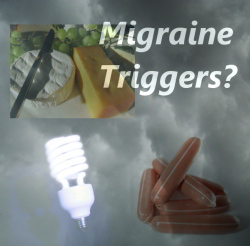Migraine Triggers: Don’t Believe the Headlines (and the myths)
Every once in a while headlines go flashing around in the media that give a completely wrong impression. For example, I’ve recently seen these headlines:
- Migraine triggers may not cause severe headaches
- Report: Migraine triggers may not be so potent
- Migraine “Triggers” May Not Cause Migraines After All
What impression do you get from these headlines? First, you might think,”Oh, we used to think that certain ‘triggers’ (ie chocolate, weather, MSG) caused migraines, but now with new research we know that they don’t!”
 |
Worse, someone might think,”Oh yeah, I have a coworker like that. She blames everything for her headaches. Maybe now she can start taking some responsibility.”
Now if you’ve only read the headlines, you’re going to be surprised about what the articles are actually about.
The actual study
Yes, there was an interesting study done, published by the journal Neurology (ahead of print on the 23rd of January 2013 – Provocation of migraine with aura using natural trigger factors). The study was small (just 27 patients), and studied only 2 “triggers” – bright/flickering lights and exercise. Although patients said that these were triggers for them, only a few reported migraine attacks after exposure (a few from exercise, none from bright lights).
That’s it? Yup.
Of course, this raises a whole boatload of questions. How long after the exposure were patients monitored? What type of bright/flickering lights? How much exercise? Of course, the study answers these questions – but that’s not the point.
The point is – what does this really tell us about migraine triggers?
Well, there’s one thing that the study suggests. The triggers that some patients report may not always immediately trigger a migraine attack.
That’s it. And that’s not a big news story.
Migraine Trigger Myths?
Are we just believing myths about triggers? Let’s take a quick look at a few…
- MYTH: A “migraine trigger” is something that causes a migraine. Actually, a trigger could “cause” an attack, in the sense that you wouldn’t have had the attack at that time if it weren’t for a certain trigger. But actually, no one knows the “cause” of migraine, and to call a trigger a cause is, in the opinion of this author, an over simplification.
- MYTH: We used to think that various things “triggered” migraine attacks, but now we know better. Actually, the trigger controversy is nothing new. For many years doctors and researchers have debated about how much influence triggers, particularly common triggers (ie chocolate, bananas, flickering lights…) have on migraine. They have debated about whether it’s better to avoid them or not.
- MYTH: Everyone with migraine has to fear the same triggers. Nonsense! Triggers are different in everyone. Though there are things that commonly trigger migraine attacks, those things may not be a problem at all for some people.
- MYTH: If X is a trigger for you, X will always result in a migraine attack. Absolutely untrue! Let’s say raw onion is a migraine trigger for you. That does not mean that every time you eat raw onion you will get a migraine attack. That may be true for some people, but not others. It’s likely that a number of triggers are working together – once you’re exposed to too many for you, an attack begins. So on a good day with few triggers, X may not lead to any problems.
- MYTH: Avoiding triggers will cure migraine. Not only will it not “cure” migraine, avoiding triggers will not always mean you won’t get any attacks. Migraine isn’t that predictable. In many cases avoiding triggers can lead to fewer attacks – in rare cases no attacks at all. But there are no guarantees.
- MYTH: A migraine trigger will always immediately result in a migraine attack. Actually, there’s a lot of disagreement over this one, particularly when it comes to food. Sure, an attack will often come almost right away. But some believe that triggers could impact you a day or even several days later. That makes it very hard to study exactly how triggers work. What if exposure to trigger X on Tuesday leads to a migraine on Wednesday – but only if you’re also exposed to Y on Wednesday? See the problem?
There was a good point that some have tried to make from this study (and I’m not blaming the study itself for the headlines). That is, many migraineurs assume that certain things will always trigger an attack, and so they avoid things that could help them. This may relate to nutrition, but it’s especially true of exercise. The benefits of moderate exercise, done properly, are in most cases going to far outweigh the problems. There are ways to minimize exercise headache and migraine.
Sure, they headlines did their job – they grabbed attention. But for so many who don’t bother to read the information carefully – particularly people who “know someone with migraine” – the headlines can be very misleading.
While we’re on the topic, here are 12 ways to Evaluate Migraine News. And more information about tracking down migraine triggers.

7 February 2013 @ 10:16 pm
Great article.
8 February 2013 @ 5:07 am
There is no doubt that if you go out on a sunny day during winter when the sun is low in the sky you will almost be forced to contract your corrugator muscles, especially if you are driving into the sun and can’t fully shade it from your eyes. The same will happen if you are subject to sustained strobe light, particularly at night – think night club, action movie at the cinema or a pack of photographers with flash lights going off all at once and for a sustained length of time.
20 February 2013 @ 10:19 am
Some more comments on this study from the New York Headache Blog: Do flickering lights and exercise really trigger migraines?
http://www.nyheadache.com/blog/do-flickering-lights-and-exercise-really-trigger-migraines/